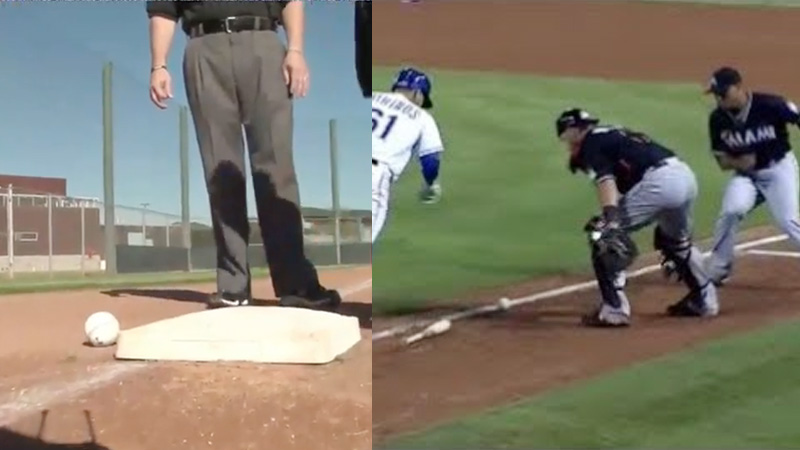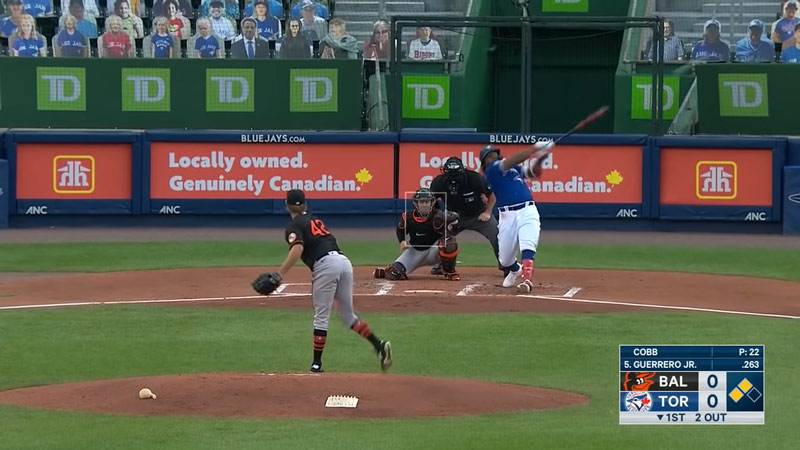Hits in baseball are a fundamental statistic that measures a batter’s success in reaching base safely by hitting the ball into fair territory and evading defensive efforts to put them out.
It is a key metric used to evaluate a player’s offensive performance and serves as a foundation for calculating batting averages.
While hits are an essential aspect of a batter’s success, it is important to understand the specific criteria that constitute a hit and the exclusions from this statistic, such as walks, errors, and interference. So, stay focused as we dig deep into the subject.
What Counts As A Hit In Baseball?
A hit is recorded when a batter successfully strikes the ball into fair territory and reaches base without any errors or fielder’s choices.
They are all considered equal when calculating a player’s batting average. A single is when the batter reaches first base, a double is when they reach second base, a triple is when they reach third base, and a home run is when they hit the ball out of the playing field, allowing them to circle all bases and score a run.
Reason to Hit the Ball Into Fair Territory
In baseball, hitting the ball into fair territory is a fundamental requirement for a hit to be recorded. Fair territory refers to the area within the boundaries of the playing field.
When a batter makes contact with the ball and sends it into fair territory, it creates the opportunity for a potential hit.
The location where the ball lands or is fielded by the defense determines the outcome of the hit. If the ball remains in fair territory and the batter safely reaches base, a hit is credited.
Differentiating Between Fair and Foul Balls

Differentiating between fair and foul balls is crucial in determining whether a hit has occurred. When a batter strikes the ball, its trajectory and location in relation to the foul lines come into play. If the ball lands within the boundaries of the foul lines, it is considered a fair ball.
On the other hand, if the ball lands outside those lines or touches any object beyond the playing field, it is deemed a foul ball. Foul balls do not count as hits and are typically considered strikes unless the batter has already accumulated two strikes.
Umpires, positioned along the baselines, make the determination of whether a batted ball is fair or foul. Their judgment is based on the ball’s position when it passes the bases. The fair/foul decision has a significant impact on the outcome of a play and the subsequent scoring of a hit.
Impact of Hitting the Ball Out of Play
When a batted ball is hit out of play, it has implications for whether a hit can be credited. If the ball is hit over the outfield fence, completely leaving the field of play without being touched or caught by a defensive player, it results in a home run.
While home runs count as hits, they are considered separately due to their unique significance in scoring runs.
However, hitting the ball out of play in other situations, such as hitting a foul ball into the stands or into a designated out-of-play area, does not result in a hit. In these instances, the batter receives another opportunity to continue their at-bat, and the hit is not counted.
Hitting the ball out of play can still have implications for the game, such as advancing baserunners or scoring runs, but it does not contribute to a batter’s hit count.
Safely Reaching Base In the Context of Hit in Baseball
Some aspects of reaching the base safely are mentioned in the next section. Please take a look at them below.
Avoiding Being Put Out by the Defensive Team
After making contact with the ball and hitting it into fair territory, a batter’s next objective is to safely reach base without being put out by the defensive team.
The defensive players will attempt to catch the ball in the air, tag the batter-runner, or throw the ball to a base to force them out. It is the batter’s responsibility to outrun or outmaneuver the defensive efforts and reach the base before the ball or the defensive player.
The ability to avoid being put out requires a combination of speed, agility, and strategic decision-making. Baserunning skills play a crucial role in maximizing the chances of reaching base safely, whether it involves sprinting to first base on a routine ground ball or stretching a hit into an extra-base opportunity.
Touching the Appropriate Base for Different Types of Hits
The base that a batter needs to touch depends on the type of hit they achieve. For a single, the batter needs to reach first base safely. In the case of a double, the second base becomes the target.
A triple requires the batter to touch third base, while a home run entails circling all four bases in order. It is important for the batter to touch each base in the correct order, without missing any bases, to ensure that the hit is properly counted.
Baserunning skills, such as rounding the bases efficiently, taking proper angles, and judging when to stretch a hit, play a crucial role in successfully touching the appropriate bases. Any failure to touch a base will result in the batter being called out, and the hit will not be counted.
Exclusion of Reaching Base via Error or Fielder’s Choice
To be considered a hit, reaching base cannot be solely a result of an error committed by the defensive team.
An error occurs when a fielder fails to make a play that an average fielder should have made, leading to the batter reaching base safely. In such cases, the batter is not credited with a hit, but the defensive player who committed the error is charged with it.
Similarly, a fielder’s choice does not count as a hit. A fielder’s choice happens when a fielder chooses to make a play on a baserunner rather than attempting to get the batter out.
If the fielder successfully forces out a preceding baserunner while the batter reaches base safely, it is not considered a hit.
The exclusion of errors and fielder’s choices from the hit count ensures that hits accurately reflect a batter’s ability to hit the ball into fair territory and reach base safely without relying on mistakes or defensive decisions.
Types of Hits in Baseball

There are four main types of hits in baseball. Please read the following section to know about them briefly.
Single: Reaching First Base Safely
A single is the most common type of hit in baseball. It occurs when a batter hits the ball into fair territory and reaches first base safely without being put out.
Typically, this involves hitting a ground ball or a line drive that falls in front of or between the outfielders. Singles are valuable as they put the batter-runner in a scoring position and keep the inning alive for subsequent batters.
Double: Advancing to Second Base Without Being Put Out
A double is recorded when a batter hits the ball into fair territory and successfully reaches second base without being put out.
Doubles often result from hitting the ball into the gaps or down the lines, allowing the batter-runner to reach second base before the defense can retrieve the ball and make a play.
Doubles are advantageous as they advance the batter-runner into scoring position and have the potential to drive in runs.
Triple: Successfully Reaching Third Base
A triple is a hit that involves the batter-runner reaching third base safely. This requires hitting the ball into fair territory and using speed and baserunning skills to advance two bases.
Triples usually occur when the ball is hit into the outfield and eludes the outfielders, allowing the batter-runner to make a complete circuit around the bases. Triples are exciting plays and can result in runs being scored due to the batter-runner’s ability to cover significant ground.
Home Run: Circling All Four Bases and Scoring a Run
A home run is the most celebrated hit in baseball. It happens when a batter hits the ball over the outfield fence, beyond the reach of the defensive players. This allows the batter-runner to circle all four bases, including touching home plate, and score a run for their team.
Home runs showcase power and can be game-changing moments, as they instantly generate a run and clear the bases. They often result from hitting the ball with tremendous force and proper trajectory.
Each type of hit carries its own level of significance and impact on the game. Singles, doubles, triples, and home runs all contribute to a batter’s offensive production and can greatly influence the outcome of a game.
Statistical Significance of A Hit in Baseball
Some aspects related to the statistical significance of a hit in baseball are mentioned in the following part. Check them out now.
Equal Weight of All Hit Types in Calculating Batting Average
In the calculation of a batter’s batting average, all types of hits—singles, doubles, triples, and home runs—are considered equal. This means that each hit, regardless of the number of bases the batter advances, carries the same weight when determining the batting average.
The principle behind this approach is to provide a standardized measure of a batter’s ability to get hits, regardless of the specific outcome or power associated with the hit.
Batting Average Calculation
The batting average is a commonly used statistic in baseball that reflects a batter’s success in getting hits. It is calculated by dividing the total number of hits by the total number of at-bats and expressing the result as a decimal rounded to three decimal places.
The formula for calculating the batting average is:
Batting Average = Hits / At-Bats
For example, if a batter has 150 hits in 500 at-bats, their batting average would be .300 (150/500 = 0.300).
Batting average provides a simple and straightforward measure of a batter’s ability to make contact with the ball and reach base safely through hits.
Importance of Hits in Evaluating Offensive Performance
Hits play a fundamental role in evaluating a batter’s offensive performance. They directly contribute to a team’s ability to score runs and win games.
The more hits a batter accumulates, the higher their chances of reaching base, advancing runners, and potentially scoring or driving in runs.
Hits are tangible outcomes that reflect a batter’s ability to make solid contact with the ball and place it in fair territory, thereby posing a challenge to the opposing defense.
Hits are a critical component of various offensive statistics beyond the batting average. They are used in calculating on-base percentage (OBP), slugging percentage (SLG), and on-base plus slugging percentage (OPS), which provide a more comprehensive assessment of a batter’s overall contribution to the team’s offense.
Hits are also important for assessing a batter’s ability to consistently produce and sustain offensive success.
Exclusions From Hits in Baseball
Some facts about exclusions from hits are discussed below. You should know them for a better understanding of baseball hits.
Walks and Hit by Pitches
While walks and hit-by-pitches contribute to a batter reaching base safely, they are not considered hits. A walk occurs when a pitcher throws four pitches outside the strike zone, and the batter is awarded first base.
Similarly, a hit-by-pitch happens when a pitcher unintentionally hits the batter with a thrown pitch, resulting in the batter being awarded first base.
Although both events allow the batter to reach base without putting the ball in play, they are tracked separately from hits in baseball statistics.
Fielder’s Choices and Errors
Fielder’s choices and errors are instances where a batter reaches base but is not credited with a hit. A fielder’s choice occurs when a defensive player chooses to make a play on a baserunner rather than trying to get the batter out.
If the defense successfully forces out a preceding baserunner while the batter reaches base safely, it is considered a fielder’s choice rather than a hit.
An error, on the other hand, happens when a fielder fails to make a play that an average fielder should have made, resulting in the batter reaching base safely. Errors are attributed to the defensive player and do not count as hits for the batter.
Interference From Defensive Players
If a defensive player interferes with a batter’s ability to hit the ball or run the bases, and the batter still reaches base, it is not considered a hit.
Defensive interference occurs when a fielder impedes the batter’s ability to make contact with the ball or hinders their progress on the basepaths. In such cases, the batter is awarded first base but is not credited with a hit.
Interference by defensive players is an infraction that disrupts the normal course of play and is distinct from a clean hit.
The exclusion of walks, hit-by-pitches, fielder’s choices, errors, and interference from hits ensures that the statistic accurately reflects a batter’s ability to hit the ball into fair territory and reach base safely without relying on defensive mistakes or unusual circumstances.
FAQs
Can a batter be credited with a hit if the ball is caught by a fielder in fair territory?
No, if a fielder catches the ball before it hits the ground, the batter is considered out and is not credited with a hit.
Is it possible for a batter to be credited with a hit if the ball bounces off a defensive player?
Yes, if a batted ball deflects off a defensive player and then lands in fair territory without being caught, the batter can still be credited with a hit. However, if the defensive player intentionally touches the ball, it may be ruled as an error rather than a hit.
Are there any specific rules regarding the distance a ball must travel for a hit to be recorded?
No, there is no specific minimum distance requirement for a hit. As long as the ball is hit into fair territory and the batter reaches base safely without being put out, it counts as a hit regardless of how far it travels.
Can a batter be credited with a hit if they reach base safely due to a fielder’s error?
No, if a batter reaches base solely due to a fielding error, it is not considered a hit. Instead, the defensive player who committed the error is charged with the mistake.
Do hits in extra innings count toward a player’s career hit total?
Yes, hits recorded during extra innings count toward a player’s career hit total and are included in their overall statistics.
Conclusion
Hits in baseball are crucial statistics that measure a batter’s ability to make contact with the ball and safely reach base. Whether it’s a single, double, triple, or home run, hits signify a successful outcome for the batter.
While hits are not the only metric used to evaluate a batter’s offensive abilities, they play a vital role in scoring runs and determining a team’s success.
Hits showcase a batter’s skill, power, and ability to contribute to their team’s offensive production, making them a cornerstone of baseball statistics. So, stay calm and enjoy your next baseball game.







